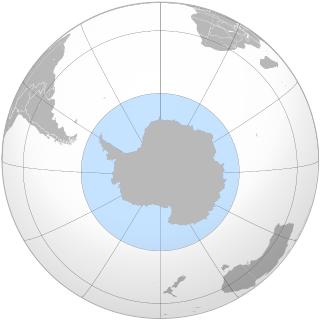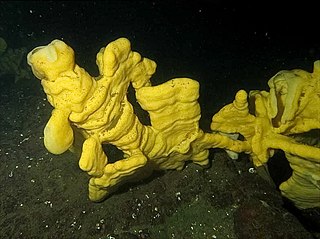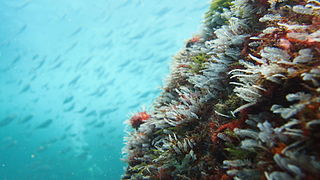
The Falkland Islands are located in the South Atlantic Ocean between 51°S and 53°S on a projection of the Patagonian Shelf, part of the South American continental shelf. In ancient geological time this shelf was part of Gondwana, and around 400 million years ago split from what is now Africa and drifted westwards from it. Today the islands are subjected to the Roaring Forties, winds that shape both their geography and climate.

The Filchner-Ronne Ice Shelf, also known as Ronne-Filchner Ice Shelf, is an Antarctic ice shelf bordering the Weddell Sea.

Sponge reefs are reefs formed by Hexactinellid sponges, which have a skeleton made of silica, and are often referred to as glass sponges. Such reefs are now very rare, and found only on the western Canadian continental shelf. Although common in the late Jurassic period, sponge reefs were believed to have gone extinct during or shortly after the Cretaceous period, until the existing reefs were discovered in 1987–1988 - hence these sometimes being dubbed living fossils.

The habitat of deep-water corals, also known as cold-water corals, extends to deeper, darker parts of the oceans than tropical corals, ranging from near the surface to the abyss, beyond 2,000 metres (6,600 ft) where water temperatures may be as cold as 4 °C (39 °F). Deep-water corals belong to the Phylum Cnidaria and are most often stony corals, but also include black and thorny corals and soft corals including the Gorgonians. Like tropical corals, they provide habitat to other species, but deep-water corals do not require zooxanthellae to survive.

The Southern Ocean, also known as the Antarctic Ocean, comprises the southernmost waters of the World Ocean, generally taken to be south of 60° S latitude and encircling Antarctica. As such, it is regarded as the second-smallest of the five principal oceanic divisions: smaller than the Pacific, Atlantic, and Indian oceans but larger than the Arctic Ocean. Over the past 30 years, the Southern Ocean has been subject to rapid climate change, which has led to changes in the marine ecosystem.

The cloud sponge(Aphrocallistes vastus) is a species of sea sponge in the class Hexactinellida. It is a deep-water reef-forming animal. The species was first described by F.E. Schulze in 1886.

Dissostichus, the toothfish, is a genus of notothen found in the Southern Hemisphere. Toothfish are marketed in the United States as Chilean sea bass or less frequently as white cod. "Chilean sea bass" is a marketing name coined in 1977 by Lee Lantz, a fish wholesaler who wanted a more attractive name for selling the Patagonian toothfish to Americans. In 1994, the U.S. Food and Drug Administration (FDA) accepted "Chilean sea bass" as an "alternative market name" for Patagonian toothfish. The toothfish was remarkably successful in the United States, Europe and Asia, and earned the nickname “white gold” within the market. Toothfishes are vital to the ecological structure of Southern Ocean ecosystems. For this reason, on 4 September a national day is dedicated to the toothfish in South Georgia.

Clathrina coriacea is a species of calcareous sponge belonging to the class Calcarea and family Clathrinidae. Species in the genus Clathrina are composed of calcium carbonate tube-like skeletons containing spicules. The sponge can be located in shallow waters widely distributed along North Atlantic coasts, as well as on other coasts.
The red encrusting sponge is a species of sea sponge. It is known only from the South African coast, on both sides of the Cape Peninsula. It is endemic to this region.
The brain sponge is a species of marine demosponge in the family Isodictyidae. This sponge is known from the west coast of South Africa to Port Elizabeth. It is endemic to this region.
Aldisa smaragdina is a species of sea slug, a dorid nudibranch, a marine gastropod mollusk in the family Cadlinidae.

The Patagonian or Argentine Shelf is part of the South American continental shelf belonging to the Argentine Sea on the Atlantic seaboard, south of about 35°S. It adjoins the coasts of Uruguay, Argentina and the Falkland Islands. Various authorities quote different dimensions of the shelf, depending on how they define its limits. Quoted statistics cites its area as being from 1.2 to 2.7 million square kilometres and its maximum width as being between 760 and 850 kilometres. The shelf itself can be divided into a 100 km band where the seabed slopes at about 1 m/km then a wide plain where the seabed slopes gently to 200 m isobath. Apart from the Falklands Plateau, the seabed then falls by up to 10 m/km to 2000 m and more.
The Burdwood Bank, called Namuncurá in Argentina and other countries, is an undersea bank with a prominence of approximately 200 m, part of the Scotia Arc projecting some 600 km (370 mi) from Cape Horn in the South Atlantic Ocean and located some 200 kilometres (120 mi) south of the Falkland Islands. Argentina claims economic rights over the whole of the bank, while the United Kingdom has designated about half of the bank as part of the Falklands Outer Economic Zone.

The tubular sponge hydroid is a species of hydroid cnidarian. It is a member of the family Tubulariidae. These animals usually grow embedded in sponges.

Temperate South America is a biogeographic region of the Earth's seas, comprising the temperate and subtropical waters of South America, including both the Pacific and Atlantic coasts of the continent and adjacent islands. It also includes the remote Gough Island and Tristan da Cunha in the South Atlantic Ocean.
Haliclona submonilifera, or the bubble bead sponge, is a deep-water demosponge from the continental shelf and slope off south-west Africa.
Hamacantha esperoides is a species of demosponge. It is commonly known as the fibrous sponge. It occurs off the southern and western coasts of South Africa, off the coast of Namibia, and off the southeast coast of South America.
Inflatella belli, or the gooseberry sponge, is a species of demosponge that appears to be restricted to the southern hemisphere, where it is widespread. It occurs from the coast of Namibia and the Indo-pacific, down to the Subantarctic and Antarctic regions.
Fibulia ramosa, or the columnar sponge, is a species of deep-sea demosponge from the southern hemisphere.

Phorbas is a genus of demosponges belonging to the family Hymedesmiidae.











